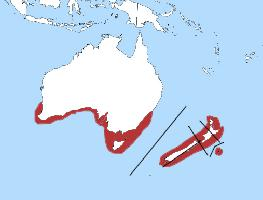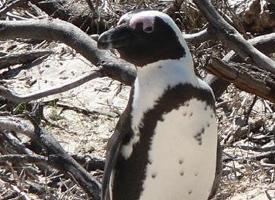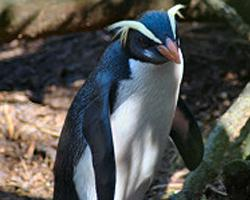
Váhy a míry
| Výška v kohoutku | od 35 do 40 cm |
|---|---|
| Hmotnost | od 1,1 do 1,6 kg |
| Rychlost | 6 km/h |
Biologická data
| Délka života | 6,5 r |
|---|
Stav ohrožení
| Ohrožen |
Popis zvířete
The Little Penguin (Eudyptula minor), also known as the Fairy Penguin due to its diminutive size, is the smallest species of penguin. With its natural habitat spanning across coastal southern Australia and New Zealand, this charming bird has captivated the hearts of many with its unique characteristics and behaviors.Adult Little Penguins typically measure about 25 to 30 centimeters (10 to 12 inches) in height and weigh approximately 1 to 1.5 kilograms (2.2 to 3.3 pounds), making them the smallest members of the penguin family. They are easily distinguished by their sleek, blue-grey plumage on the back, which contrasts sharply with their stark white bellies. This coloration not only adds to their enchanting appearance but also serves as a form of camouflage while swimming, protecting them from predators by blending in with the reflective water surface when viewed from above and merging with the lighter sea surface when seen from below.
One of the most remarkable features of the Little Penguin is its lifestyle and breeding habits. These birds are monogamous during a breeding season, with pairs often returning to the same nesting sites year after year. They make their nests in burrows dug into sand dunes or in natural crevices among rocks, showing a strong preference for habitats that provide protection from predators and harsh weather. The breeding season varies depending on their geographical location but generally occurs between July and December. During this time, the female typically lays one or two eggs, which both parents take turns incubating. The chicks are born with a soft, downy plumage, which they shed for their waterproof feathers after about eight weeks, marking the beginning of their life at sea.
The diet of the Little Penguin primarily consists of small fish, squid, and krill, which they hunt during the day. They are excellent swimmers, using their flippers to propel themselves through the water with remarkable speed and agility. These penguins can dive to depths of over 60 meters (197 feet), though they usually hunt in shallower waters.
One of the most endearing sights for those lucky enough to observe these creatures in the wild is their evening return to shore, known as the "penguin parade." At dusk, groups of Little Penguins emerge from the ocean and waddle back to their nests in a highly social and communal display. This event has become a popular attraction in places like Phillip Island in Victoria, Australia, where visitors can watch these delightful birds make their nightly journey.
Despite their popularity and protected status in many areas, Little Penguins face significant threats from habitat destruction, pollution, and predation by introduced species such as foxes, dogs, and cats. Climate change also poses a long-term threat by affecting the availability of their prey. Conservation efforts are in place to protect these enchanting birds, including habitat restoration, predator control programs, and research into their behavior and ecology to better understand how to ensure their survival.
In conclusion, the Little Penguin is a fascinating and uniquely charming bird, whose life in the harsh coastal environments of the southern hemisphere showcases the incredible adaptability and resilience of nature. Their continued survival depends on our commitment to protecting their habitats and mitigating the threats they face, ensuring that future generations can continue to be delighted by the sight of these remarkable animals.
Mapa výskytu

Podobná zvířata
Nové fotografie zvířat
Top 10 zvířat
- Dolphin gull (Leucophaeus scoresbii)
- Diana monkey (Cercopithecus diana)
- Moustached guenon (Cercopithecus cephus)
- Galápagos tortoise (Geochelone nigra complex)
- Stone loach (Barbatula barbatula)
- Japanese macaque (Macaca fuscata)
- Greek tortoise (Testudo graeca)
- Russian tortoise (Testudo horsfieldii)
- Common flying dragon (Draco volans)
- Galápagos penguin (Spheniscus mendiculus)


